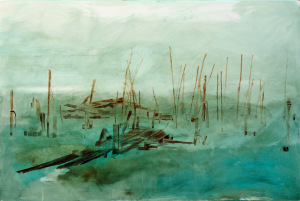
“Travessia” – 100 x150 óleo s/ tela. 2013
I became acquainted with the work of Catarina Pinto Leite in 2007, on the occasion of an exhibition in which she showed landscapes. Since then, she continued to produce serious and demanding paintings, anchored on the work around space and the shapes that stand out from it. At times centered on the schematic representation of nature’s place, other times on the more experimental work related to the possibilities of abstraction, I am now, as once before, impressed by her extreme technical mastery and the perseverance with which she continuously builds an original and authentic body of work.
Her most recent series remains centered on the landscape, a genre filled with possibilities, which she has chosen amongst all others. However, in the space made up of glazes with blue or golden tones, we can make out ruins of bridges, boardwalks and wooden piers. For those who have already visited them, these constructions are impressive in terms of the speed at which they are destroyed by the climate and rebuilt according to human needs. The beauty of these ephemeral constructions resides in this aspect that they never relinquish, countered by the ability to replicate and multiply according to human will.
In these ruins, Catarina highlights form and function, the two key elements. This last one can be found in the juxtaposition of dark oblique lines that fill part of the space available. The first one, in a concept she adopted for the series, which materializes in the reflection about the bridge, the link, the connection.
The bridge: if in ancient landscape paintings it always possessed a very precise functional and symbolic meaning (of visually uniting two distinct planes, and of metaphorically reinforcing the idea of self-discovery or self-reflection, which was always implied in the romantic landscape), today that ability is reinforced through the multiplicity of connections, real and virtual, that our contemporaneity has created. And yet, notwithstanding the undeniable benefits that contemporary technology has brought us, never, more than today, have we been in danger of living isolated, distant from our peers, closed up in front of our computer screens or tablets, with a social life limited to text messages, emails and other messages in murals, fragile bridges reduced to their most closed up expression.
In a beautiful text by Rui Marques that Catarina shared with me, and which inspired her while working on this series, the author talks about the ancient pontiffs of the Roman Empire, those who “built bridges”. Today, the word is exclusively associated with Catholicism. But, recovering its original meaning, Rui Marques speaks of a symbolic construction that, when materialized, transforms the subject, “gains colors it didn’t have” and “sees the world through a different window”. And so we return to painting: what for centuries was a window to the world is now, in our contemporaneity, a window to the subjectivity of the artist.
Thus, the bridges mentioned in that text can, or not, replicate a form apprehended by vision, or translate into a purely abstract exercise where the distance between dark and light tonalities, between thickness and transparency, between the visible gesture and smooth surfaces is transposed through painting.
Luísa Soares de Oliveira